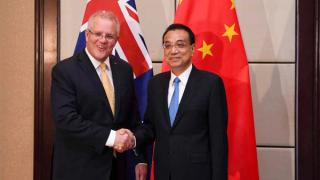In Homer’s Odyssey, Scylla was a deadly beast who lived on one side of a narrow channel of water. On the other side dwelt the sea monster Charybdis. The two were equally dangerous, and sailing too close to either meant destruction and probably death. For Odysseus, steering safely though the middle passage required navigational skill and extreme caution.
At this week’s East Asia Summit in Bangkok, the resonance of the ancient Greek metaphor is obvious. Can the region’s middle powers – Australia, Malaysia, Vietnam, the Philippines and others – navigate between two equally dangerous monsters, the People’s Republic of China and the United States of America?
In the past, common wisdom held that safety was found in not choosing one side or the other, and that all great powers were equally dangerous. Yet it is increasingly clear that those assumptions no longer hold. Several factors suggest that while many of these nations may continue to hedge in public, they may need to make other choices in private.
However much these countries worry about America, and especially the White House’s erraticism, the more pressing question is how to deal with a rising and increasingly assertive China. Fears of American abandonment and inattention have long pervaded Asian capitals and will continue regardless of America’s actions, because Washington is so often focused on events elsewhere in the world. But there is no escaping Beijing.
Moreover, the increasingly assertive turn in Chinese foreign policy under President Xi Jinping has blurred the distinction between countries on the front line and those less affected. Japan has seen continuous pressure exerted by Chinese maritime forces to alter maritime boundaries. Australia has been on the receiving end of a widespread campaign of political interference run by Beijing’s United Front Work Department intended to shape and condition its sovereign political decisions.
South Korea was punished by a slowdown in Chinese tourism and the ejection of South Korean businesses from China after Seoul installed a missile defence system of which Beijing disapproved. The Philippines, which attempted to check Beijing’s ambiguous and expansive claims in the South China Sea by submitting the dispute to an international court of arbitration, has been subjected to an ongoing campaign of harassment and intimidation of its fishing fleets by China’s maritime militia and coast guard. Vietnam, which has challenged incursions into its territorial waters, has been on the receiving end of cyber attacks.
This partial list only underscores the larger point that as Beijing’s power has grown, so too has its ability to affect more countries in more ways.
Policy responses have differed in tone and intensity. The Philippines has gained remarkably little from Beijing despite President Rodrigo Duterte’s announcement of “separation” from the US and realignment with Beijing and Moscow. Malaysia, by pushing back against what Prime Minister Mahathir Mohamad deemed Beijing’s “new version of colonialism”, was able to renegotiate infrastructure deals on more favourable terms. Meanwhile, Japan has resisted China’s consistent pressure in the East China Sea, and is playing a leading role in forging new ties across the region while improving its relationship with Beijing.
Safe passage
Most Indo-Pacific countries will likely want to continue to hedge, desiring to derive as much benefit from both powers as possible while also avoiding sticking their necks out too far. But it is clear that they are trying to figure out a way forward as the safe passage between the shorelines grows ever more narrow. Three starting points should inform their course.
First, regional co-ordination needs to intensify, and should include more robust discussions of the problems each nation is facing and what responses seem to work best. All Indo-Pacific nations are now dealing with Chinese aggression – sometimes forceful and coercive, sometimes implicit and suggestive. And Beijing is tailoring the pressure, varying its approach from country to country. This has been effective for China because thus far each country has addressed this coercion as a bilateral issue. Broader discussion of problems and successful responses would allow best practice to be widely disseminated, and help countries to pool knowledge and resources.
Second, to accrue maximal benefits from both sides, smaller countries need the ability to hedge more effectively. A nation that accepts investment, funding or development aid from only one big power will become overly reliant on that country. Similarly, countries that have neither the ability to defend themselves nor the capacity to inflict asymmetric costs on would-be aggressors are easy targets for coercive activities. But nations that make themselves attractive destinations for investment while also building the capacity of their armed forces stand a greater chance of enhancing their prosperity and preserving their independence.
Finally, countries are increasingly being forced to take sides on technology developments in fields such as space exploration, artificial intelligence, quantum computing, robotics and 5G network infrastructure. The decisions that governments take, especially on 5G, will lock them into dependent relationships with system providers and determine the strategic and economic risks they will face over the long run. The nations that are most likely to thrive in an increasingly bifurcated world are those that make their policy decisions based on long-term implications as well as immediate costs.
Middle powers in the Indo-Pacific region are understandably anxious and concerned, as the middle path they have hewed to in the past continues to narrow. But as understanding spreads of the risks posed by engagement with China they would be wise to focus on strengthening their capacity to resist. That will help them counter the worst of China’s coercion and secure a prosperous future for their citizens.






